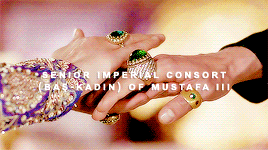#selim iii
Explore tagged Tumblr posts
Note
I maintain my point that the Janissaries were dumbasses. How are you going to vocally support and praise someone else and actively go against the leading Sultan? Like how in your mind do you imagine that working out? In MCK when they were mad at Murad and opening chanting “long live Shezade Bayezid, long live Sehzade Kasim!” If I’m either one of them I’m sweating intensely and if I’m Murad I’m calling for an executioner
Were they, though?
Mathematically, there were more Janissaries than Murad IV LOL
Leaving jokes aside, Osman II's reign had demonstrated that if you lost control of the army (and the janissaries were a powerful component of it) you did not fare well. In 1632, when they asked to see the other princes (and to take hold of them), they were in a position of power. They had just executed Murad IV's favourite, Musa Çelebi, literally the closest person to the sultan. They clearly showed they were not joking.
Can you, though, execute all those people? Let's say there are thousands of them cramming the gates of Topkapi Palace.. a) how do you physically drag each one of them on a block to be executed? and b) would your guards do it? Don't you think your own guards wouldn't agree to execute thousands of their own?
The Ottoman sultan is an absolutist monarch, there's no doubt about that, but in practice, absolute power is not absolute power at all. Louis XIV is the one you think about when you say absolutism, but he didn't have absolute power. No monarch had absolute power. Absolute power doesn't exist, you always have to compromise in some way (and Louis XIV had to compromise a lot).
Murad IV had to swallow the bitter pill in 1632 and bend to their requests. They were stronger than him, at that time. He had his revenge later, when he had a stronger hold on the empire and had the chiefs of the rebellion captured and executed. When the riots started, he knew that Topal Paşa was behind the rebels but he couldn't do anything against him. Not right away.
Murad IV was violent and every other derogative term you want to use but he wasn't stupid. He knew politics very well, he knew how to rule. He learned it on the field, literally. During his campaigns, he stayed with the army, talked to them, etc etc. At the end of his reign, the Janissaries were completely by his side.
I mean, there's a reason why only in the XIX century the sultan managed to eliminate them. Selim III, at the end of the XVIII century, was deposed because he dared innovate the army.
23 notes
·
View notes
Photo










Royal Birthdays for today, December 24th:
Galba, Roman Emperor, 3 B.C.
John, King of England, 1166
Constance of Austria, Queen of Poland, 1588
Honoré II, Prince of Monaco, 1597
Mariana of Austria, Queen of Spain, 1635
Selim III, Ottoman Sultan, 1761
Elena Pavlovna, Hereditary Grand Duchess of Mecklenburg-Schwerin, 1784
Elisabeth, Empress of Austria, 1837
Cristina, Princess of Bourbon-Two Sicilies, 1869
Alexandrine of Mecklenburg-Schwerin, Queen of Denmark, 1879
#king john#elisabeth of bavaria#mariana of austria#constance of austria#selim iii#galba#honore ii#elena pavlovna#cristina of bourbon two sicilies#Alexandrine of Mecklenburg-Schwerin#long live the queue#royal birthdays
58 notes
·
View notes
Photo

9 notes
·
View notes
Text
Salim III: Semangat Jihad yang Kembali Bergelora
Salim III (berkuasa 1789-1807) menduduki jabatan sultan usai pamannya, Abdul Hamid, meninggal dunia. Di awal masa jabatannya, Salim langsung menggelorakan kembali semangat yang telah lama hilang dari kesultanan ini, yang menjadi sebab kesuksesan dan kebesarannya di hadapan seteru-seterunya, yaitu semangat jihad. Ia berpidato dengan sangat berapi-api, demi mengobarkan kembali semangat jihad yang mulai meredup, sembari mengingatkan kembali akan kemenangan-kemenangan yang pernah mereka raih atas musuh-musuhnya di hari-hari silam. Semangat inilah yang kemudian membuat Salim menolak semua perjanjian damai yang ditawarkan Spanyol, Prancis, dan Rusia. Di sisi lain, ia sadar, penderitaan rakyatnya tak lepas dari kekalahan demi kekalahan yang terus diderita Utsmani. Maka, menindaklanjuti sikapnya, ia langsung maju sendiri memimpin pasukannya menuju Danube. Di saat yang sama, Prancis mulai melirik Mesir untuk melebarkan ekspansi mereka. Pun halnya dengan Inggris. Keduanya berebut pengaruh di sana. Namun, Eropa sepertinya mulai lelah dengan perang yang seolah tak ada ujungnya ini. Lobi diplomatik terus diusahakan dan perdamaian terus diserukan. Namun, waktu terus berjalan dan kekalahan untuk pihak Utsmani terus-menerus terjadi, membuat rakyat marah dan kesal, bahkan ada suara-suara yang ingin Perdana Menteri turun akibat kekalahan yang terus terjadi itu. Revolusi Prancis membuat negara itu mengalihkan perhatiannya, dan Eropa memandang ini adalah saat yang tepat untuk menghentikan perang, agar pasukan pimpinan Napoleon Bonaparte tidak semakin menggila dalam menggerogoti satu per satu daerah kekuasaan Utsmani. Maka akhirnya ditandatangani Perjanjian Zastaway yang terkenal itu, pada tahun 1791 M. Namun, Salim tetap ingin meneruskan semangat jihad para leluhurnya. Pemberontakan Janissary yang berujung pada pemakzulannya dari posisi sultan pada tahun 1807 M, lalu wafatnya ia akibat terbunuh setahun setelahnya, menjadi penutup kisah hidupnya. Selanjutnya, Mustafa IV naik menggantikannya sebagai sultan. (Sumber: Artikel Republika: Salim III - Semangat Menggebu untuk Berjihad; Selim III - Wikipedia; Bangkit dan Runtuhnya Khilafah Utsmaniyyah, dengan pengubahan)
3 notes
·
View notes
Photo


First Serbian Uprising
1. Battle of Mišar by Afanasij Šeloumov 2. Death of Hajduk-Veljko Petrović during battle for Negotin 1813 by Stevan Todorovic
Throughout the eighteenth century, Serbian autonomy and political stability both eroded as numerous wars between the Hapsburgs and Ottomans ravaged Serbian lands, prompting thousands of refugees to flee into Hungary. When war did not ravage the countryside, unemployed and restless Janissaries sought wealth at the expense of both Christian and Muslim peasants. In January and February of 1804, tensions came to a head when the Janissaries murdered between 70 and 150 Serbian notables to prevent the nation from establishing a threat to their violent hold over the country. Initially, Selim III ignored the violence in Serbia as he lacked the resources to police his rapidly decentralizing empire. Under pressure, Selim eventually sent Hafiz Pasha to stop the rebellion, but his troops were effectively halted. The Ottoman government appeared willing to grant concessions. Nevertheless, the revolutionaries did not trust the Sublime Porte to successfully enact new regulations and, moreover, Russia had begun hostilities against the Ottomans.
Russia sent an emissary--with much less authority than the Serbians were aware of--to negotiate with Serbian leader Karadjordje Petrovic. The emissary promised Russian assistance, but Russia was soon to negotiate peace and left Serbia in a vulnerable isolated position. Serbia, despite lacking preparedness, held its ground in the countryside until Selim was overthrown by Mahmud II in 1808. Hostilities recommenced in 1809 when fighting between Russia and the Ottomans erupted yet again. Petrovic again promised support and initially gained victories before a crippling defeat at Nis. In 1810 the tides turned when Alexander I of Russia sent troops and supplies directly to Serbian territory. France began its invasion of Russia shortly thereafter and a truce was negotiation without Serbian approval. By the end of the first rebellion in 1813, the Serbians did not have the manpower or resources to continue campaigning. Nevertheless, the Second Serbian Uprising would occur shortly thereafter and carry on the objectives the First Uprising fought for.
Charles and Barbara Jelavich, The Establishment of the Balkan National States: 1804-1920. The University of Washington Press (2000), pp. 26-35.
71 notes
·
View notes
Photo

Ottoman Sultan Selim III (1766-1808), ca 1805.
source
9 notes
·
View notes
Note
Hello,could you give me some info about Selim III’s consorts.
Unfortunately, not much is known about his consorts.
Nefizar Kadın: Selim III's Senior Imperial Consort, she is variously called Nafizar, Safizar or Sefizar. Nothing is known about her, only that on 28 May 1792 she celebrated Ramadan with the sultan. She died two days later, on May 30th. She was buried in the room next to the Laleli tomb.
Afitab Kadın: she probably became Senior Imperial Consort after Nefizar's death. She may have died in the same year of Selim's deposition.
Zibifer Kadın: also called Ziybülfer, she was Selim III's Second Imperial consorts. After the death of her husband, she moved to a palace on the Bosphorus, where she died on 10 March 1817. She was buried in the Büyük Selimiye Mosque in Üsküdar.
Tabisefa Kadın: Third Imperial Consort, when Selim III was deposed, she was moved to Fındıklı Palace, where she died on 14 March 1854/1855. She was buried outside the Laleli tomb.
Refet Kadın: Fourth Imperial Consort of Selim III, she died at the exceptional age of 90 on 22 October 1867 and was buried in the mausoleum of Mihrişah Valide Sultan in Eyüp. Refet Kadın was one of the two concubines with Selim who tried to prevent the sultan's assassination, when the executioners appeared. She first cried out and tore at her hair, and then threw herself on the sultan's body to protect him but the executioners managed to move her to finish the job.
Nüruşems Kadın: Fifth Imperial Consort, she died in May 1826 and was buried in the Laleli tomb.
Hüsnümah Kadın: Sixth Imperial Consort, she was given lands in Tire by Selim III. She died in 1814 and was buried in the Laleli tomb.
Demhoş Kadın: does not appear in Sicill-i Osmani, but there is a register in the Topkapi Palace Archives called "Demhoş Kadın's accounts", where it shown that she received revenues for the period 1799-1806. Nothing else is known about her.
Goncenigar Kadın: she was found in the same register that gave us the name of Demhoş Kadın. Nothing else is known about her.
Mahbube Kadın: her name was found in the same register that talked about Goncenigar ve Demhoş.
Aynısefa Kadın: discovered by Uluçay thanks to a list which showed her as one of the recipient of some kind of payment dated 1794, after which she disappears.
Pakize Hanım: one of Selim III's favourites, she was with him when he was assassinated. She threw herself between the sultan and the executioners and was injured at one hand.
Meryem Hanım: Selim III's only known ikbal based on a document dated 22 August 1807.
#anon#ask post#ask: ottoman history#selim iii#nefizar kadin#afitab kadin#zibifer kadin#tabisefa kadin#refet kadin#nurusems kadin#husnumah kadin#demhos kadin#goncenigar kadin#mahbube kadin#aynisefa kadin#pakize hanim#meryem hanim
14 notes
·
View notes
Photo










Royal Birthdays for today, December 24th:
Galba, Roman Emperor, 3 B.C.
John, King of England, 1166
Constance of Austria, Queen of Poland, 1588
Honoré II, Prince of Monaco, 1597
Mariana of Austria, Queen of Spain, 1635
Selim III, Ottoman Sultan, 1761
Elena Pavlovna, Hereditary Grand Duchess of Mecklenburg-Schwerin, 1784
Elisabeth, Empress of Austria, 1837
Cristina, Princess of Bourbon-Two Sicilies, 1869
Alexandrine of Mecklenburg-Schwerin, Queen of Denmark, 1879
#selim iii#elena pavlovna#elisabeth of bavaria#cristina of bourbon two sicilies#Alexandrine of Mecklenburg-Schwerin#Mariana of Austria#honore ii#constance of austria#king john#galba#long live the queue#royal birthdays
57 notes
·
View notes
Photo

Portrait of Sultan Selim III.
*Dönemine göre radikal ıslahatları ve müzisyen kimliği ile anılması gereken, 28. Osmanlı padişahıdır (Based on his period, III. Selim should be referred to his radical reforms and ‘musician’ identity).
18 notes
·
View notes
Photo

Tughra of the Ottoman Sultan Selim III in the Diwani style - 16th century.
45 notes
·
View notes
Photo








VALIDE SULTANS: "The change in Harem life began with the sensitive and unusually intelligent sultan, Selim III, who was murdered in 1807. Part of his zeal for reform came from his mother, Mihrişah Valide, to whom he was devoted. A Georgian, she was said by Dr Neale (the pre-eminent physician of his day who made a tour of German, Poland and Ottoman territory at the beginning of the nineteenth century) to have had more influence on her son that any other Valide had done before. It was certainly she who introduced baroque to Topkapisaray, and to her own gorgeous apartments in particular [...]" -- Godfrey Goodwin, The Private World of Ottoman Women // Ipek Tenolcay as Mihrişah
#history#historyedit#mihrisah sultan#selim iii#hibetullah sultan daughter of mustafa iii#fatma sultan daughter of mustafa iii#ottomanladiesedit#validesultans
745 notes
·
View notes
Photo










Royal Birthdays for today, December 24th:
Galba, Roman Emperor, 3 B.C.
John, King of England, 1166
Constance of Austria, Queen of Poland, 1588
Honoré II, Prince of Monaco, 1597
Mariana of Austria, Queen of Spain, 1635
Selim III, Ottoman Sultan, 1761
Elena Pavlovna, Hereditary Grand Duchess of Mecklenburg-Schwerin, 1784
Elisabeth, Empress of Austria, 1837
Cristina, Princess of Bourbon-Two Sicilies, 1869
Alexandrine of Mecklenburg-Schwerin, Queen of Denmark, 1879
#elisabeth of bavaria#elena pavlovna#Mariana of Austria#selim iii#Alexandrine of Mecklenburg-Schwerin#cristina of bourbon two sicilies#honore ii#constance of austria#king john#galba#long live the queue#royal birthdays
31 notes
·
View notes
Text
On this day, 29 May, in Ottoman history
29 May 1453 - fall of Constantinople: started on April 6th, the siege lasted until three hours from dawn, on 29 May 1453, when the third assault of the Ottoman army succeded and finally entered the city. The contemporary Tursun Bey narrated the siege: “Once the [cloud of] smoke of Greek fire and the soul of the Fire-worshipping [i.e., infidel] Prince had descended over the castle ‘as though a shadow’, the import was manifest: the devout Sultan of good fortune had, as it were, ‘suspended the mountain’* over this people of polytheism and destruction like the Lord God himself. Thus, both from within and without, [the shot of] the cannons and muskets and falconets and small arrows and arrows and crossbows spewed and flung out a profusion of drops of Pharaonic-seeming perspiration as in the rains of April – like a messenger of the prayers of the righteous – and a veritable precipitation and downpouring of calamities from the heavens as decreed by God. And, from the furthest reaches below to the top-most parts, and from the upper heights down to ground level, hand-to-hand combat and charging was being joined with a clashing and plunging of arms and hooked pikes and halberds in the breaches amidst the ruin wrought by the cannon.”
29 May 1675 - end of the circumcision feast of Mehmed IV’s sons Mustafa and Ahmed: the circumcision feast had started on May 14th and lasted fifteen days in Edirne Palace. “Banquets, lavish gifts, theatre performances, fireworks, clowning, equestrian displays and much more besides went to make up a scrupulously orchestrated exhibition of dynastic splendour and munificence. Ottoman officials and dignitaries and the people of Edirne were invited to feasts according to their rank, and presented their offerings to the Sultan and the Princes – religious and poetic texts, silver vessels and valuable cloth predominated.” – Caroline Finkel, Osman’s Dream: the History of the Ottoman Empire
29 May 1807 - deposition of Selim III: the sultan had tried to appease the rebels by appointing conservatives in the government but this only emboldened them, who eventually managed to get a fatwa against the sultan. Sheikhulislam Ataullah Efendi, the mediator appointed by Selim III to speak with the rebels, was chosen to enter the palace and announce that the sultan had been deposed. The palace gate was closed, so a letter was sent inside which stated that the crowd outside the palace would not give up until Selim III stepped down and the oath of allegiance to Prince Mustafa was performed. 50,000 people outside the palace and Hagia Sophia chanted “we want Sultan Mustafa”. Despairing, Selim III acconsented and sent someone in the harem to fetch his cousin Mustafa. He retired to the kafes.
29 May 1807 - enthronement of Sultan Mustafa IV: a throne outside the Gate of Felicity was set up and the new sultan emerged to listen to the oath of allegiance of his new statesmen. Afterwards, prayers were held in Hagia Sophia and Mustafa IV declared that “the reforms had been created by evil associates of the sultan to secure power and money for themselves [and that] they had destroyed order, violated law and tradition, and caused all the anarchy and defeats that had torn the empire asunder during Selim’s reign. Thereafter, the traditional laws and institutions would prevail.” – Stanford J Shaw, History of the Ottoman Empire and Modern Turkey (volume I)
29 May 1868 - birth of Abdülmecid Efendi, last Caliph of Islam: son of Sultan Abdülaziz and his consort Hayranidil Kadın. An avid painter, he painted scenes of the harem and his favourite wife Şehsuvar Başkadın. Abdülmecid became the beacon of statesman dissatisfied with the new regime, and thought that the sultanate could be reinstated. When he asked Mustafa Kemal for more privileges, the president answered “Let the caliph and the whole world know that the caliph and the caliphate which have been preserved have no real meaning and no real existence. We cannot expose the Turkish Republic to any sort of danger to its independence by its continued existence. The position of Caliphate in the end has for us no more importance than a historic memory.” On 3 March 1924, Mustafa Kemal pushed for the abolition of the caliphate as well, souring relations with the moderates inside the party.
#history#on this day in history#on this day in ottoman history#mehmed ii#selim iii#mustafa iv#abdulmecid ii#late ottoman empire#mehmed iv#mustafa ii#ahmed iii
14 notes
·
View notes
Text
On this day, 28 May, in Ottoman history
28 May 1524 - birth of Selim II: son of Süleyman I and his wife Hürrem Sultan, he was one of the most criticised sultans for preferring peace to war and conquests. Selim II resembled his father only in his family structure, as he too married his favourite consort and his daughter was the wife of the Grand Vizier. Contrary to Süleyman I, he singled out his son Murad with his wife Nurbanu Sultan as heir to the throne, thus preventing a fight among different factions in the government. Selim II was called “the blond” by his subjects, for the fair hair he had taken from his mother, and “the mest” by the Europeans, who did non fear him as they had feared his father Süleyman.
28 May 1807 - Selim III was accused of harming the heirs to the throne: during the rebellion started against the "New Order" of the sultan, the soldiers asked for evidence that the heirs to the throne - Sultan Abdülhamid I’s sons Mustafa and Mahmud - would not be harmed. The sultan replied like this: "I have no children. The Princes are my sons and the light of my eye. God forbid that I should be the cause of extinguishing and annihilating the state and dominion of the Ottoman dynasty and the pure Ottoman line by assassinating them. I could never entertain such thoughts. Pray God that day will never come. Let God give them long life!"
19 notes
·
View notes
Text
On this day, 24 May, in Ottoman history
24 May 1807 - Selim III ordered the army to wear the new european-style uniforms: former chancellor Mahmud Raif Efendi, superintendent of the Upper Bosphorus fortresses guarding the Black Sea, read to his men the Sultan’s decree that “they must accept the ‘New Order’ and adopt its uniform”. This provoked disorders among the army and Mahmud Raif Efendi was shot in the stomach by the leader of the garrison, after he had showed the new uniforms.
24 May 1903 - birth of Behruze Hanım: she was Caliph Abdülmecid’s head treasurer, though she was considered by some as one of his wives. She was born in an Abaza village; no information is known about her family. She died after 1955, in Istanbul.
#history#ottoman history#on this day in history#on this day in ottoman history#selim iii#behruze hanim#late ottoman empire
13 notes
·
View notes
Text
On this day, 7 April, in Ottoman history
7 April 1789 - death of Abdülhamid I; 27th sultan of the Ottoman Empire, he was the son of Ahmed III and Rabia Şermi Kadın. He spent 44 years in the Kafes, but was allowed to have concubines and at least one baby daughter was smuggled out and raised outside the palace. He was the ancestor of the last eight sultans of the Dynasty.
7 April 1789 - Prince Selim assumes the throne as Selim III; son of Mustafa III and Mihrişah Valide Sultan, he spent 28 years in the kafes. He had 12 consorts but no children. He ruled for 18 years before being deposed in May 1807 for his cousin Mustafa IV.
14 notes
·
View notes